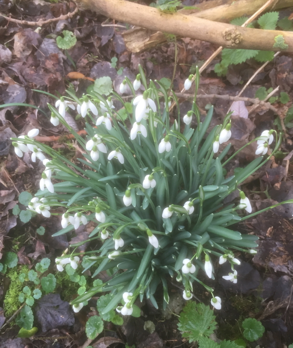These wild snowdrops bloom by a path I often take. In the middle ages it was a road but today it is only a track-way.

Linnaeus named this flower Galanthus nivalis; Galanthus from Greek gala+anthos, 'milk-flower', and nivalis from Latin 'of snow'.
The common name snowdrop is only recorded from the 17 c and the origin is unclear, although the Oxford English Dictionary suggests a connection with the German schneetropfen, which itself possibly comes from the name of a kind of earring once popular.
It is probably only the German Schneetropf, and originates from the resemblance of the form of the flower to that of an ear-drop or the ornaments which ladies have at various times had suspended from their brooches and other articles of jewellery.
Transactions and journal of the proceedings of the Dumfries and Galloway Natural History and Antiquarian Society, 1906.
Surprisingly Galanthus turns to have pharmacological importance. Some species of the genus are a source of galanthamine, which was traditionally used in eastern European countries for treating polio, and is now used for slowing the progress of Alzheimer's.
* My title "The snow-drop paths of innocence" comes from W. R. Spencer.